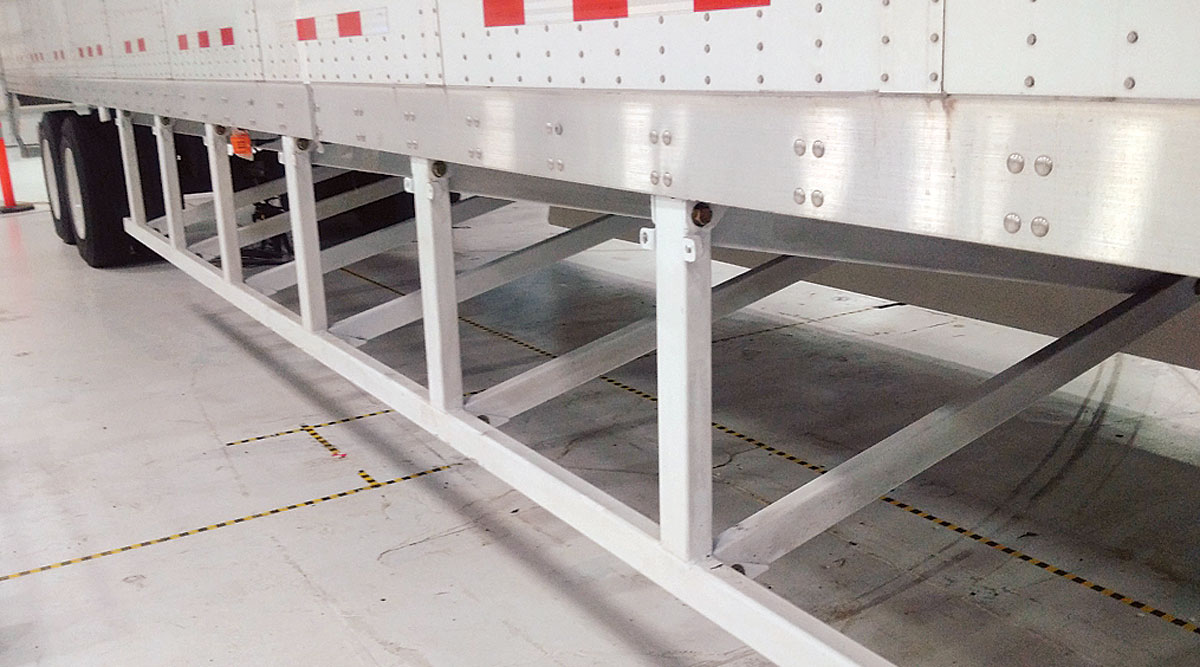Senior Reporter
IIHS Supports Side Underride Guards Mandate

This story appears in the May 15 print edition of Transport Topics.
The Insurance Institute for Highway Safety said May 10 it supports creating a new safety mandate requiring side underride guards on semitrailers to help reduce a leading cause of truck-involved accident fatalities. The move follows a March visit to Capitol Hill from citizen advocates who presented lawmakers with draft language of a bill requiring more underride protection on various trucks.
Federal law requires large trucks to have rear underride guards but not side guards, IIHS said.
In 2015, 301 of the 1,542 passenger vehicle occupants killed in two-vehicle crashes with a tractor- trailer died when their vehicles struck the side of a tractor-trailer, IIHS said, citing its own data. This total compares with 292 people who died when their passenger vehicles struck the rear of a tractor-trailer, according to the institute.
Because of gaps in federal crash data, IIHS said its researchers could not determine exactly how many of those side crashes involved underride contact, but — using law enforcement’s photographic documentation of crashes in Indiana — they estimated underride occurs in about 50% of fatal crashes between large trucks and passenger vehicles.
“Our tests and research show that side underride guards have the potential to save lives,” David Zuby, the institute’s executive vice president and chief research officer, said in a statement. “We think a mandate for side underride guards on large trucks has merit, especially as crash deaths continue to rise on our roads.”
Tests conducted this spring marked the first time IIHS had evaluated a side underride guard, according to the institute. A 2012 IIHS study found that strong side underride guards have the potential to reduce risk of injury in about 75% of large truck side crashes producing a fatality or serious injury to a passenger vehicle occupant.
 AirFlow Deflector Inc.
AirFlow Deflector Inc. Dedicated to reducing deaths, injuries and property damage from motor vehicle crashes, IIHS is wholly supported by auto insurers.
Trailer makers said they were prepared to adjust to any mandate.
“We do not currently offer this feature. Like other manufacturers, we have looked at the concept but have not yet found a way to make them commercially viable,” Glenn Harney, chief sales officer at Hyundai Translead, told Transport Topics. “If the government makes them mandatory, we would, of course, do our best.”
Use of side guards will have to emerge from regulations, “or else the playing field won’t be level, and no one is going to accept it,” said Charles Willmott, chief sales officer at trailer maker Strick Group.
“If the industry wants heavier trailers and to spend more money, we can reduce [the number of fatalities] with side impact [guards]. So from a public safety standpoint, that makes, potentially, good sense,” Willmott said.
“It’s important to recognize that all crashes are tragedies, but we also need to recognize that these guards are collision mitigation and not collision avoidance equipment, and ATA’s primary safety goal is to prevent crashes,” said Sean McNally, a spokesman for American Trucking Associations.
IIHS conducted two crash tests in the side underride scenario earlier this year.
The first test involved a protective frame made of midgrade steel and measuring 20 feet long by 23 inches high and 101 inches wide. Along each side of the trailer, a horizontal bar served as the frame’s bottom edge. Welded to the horizontal bar were several evenly spaced vertical bars that bolted to the trailer’s cross rails. Underneath the trailer, a grid of crisscrossed metal struts reinforced the frame. The trailer also had a side skirt on it.
Montréal-based AirFlow Deflector Inc. designed the protective product it calls AngelWing. The frame weighs about 800 pounds, according to the company.
Also tested was an aerodynamic fiberglass side skirt, with no underride guard.
In both tests, a midsize car traveling at 35 miles per hour struck the center of a 53-foot-long dry van trailer, according to the institute.
In the first test, the underride guard bent but did not allow the car to slide underneath the trailer, IIHS said, and the car’s air bags and safety belt properly restrained the test dummy in the driver seat.
In the second test, the car ran into the trailer’s aerodynamic side skirt and kept going. The impact sheared off part of the car’s roof, and the sedan became wedged beneath the trailer, IIHS said, noting that in such a real-world crash, any occupants in the car likely would sustain fatal injuries.
At least three U.S. cities — Boston, New York and Seattle — mandate side guards on city-owned and/or contracted trucks to prevent crash deaths and injuries, particularly among pedestrians and bicyclists, IIHS said.
As of May 10, the citizen advocates’ draft legislation — the Roya, AnnaLeah and Mary Comprehensive Underride Protection Act of 2017 — had not been introduced in Congress, according to a search of thomas.gov.

